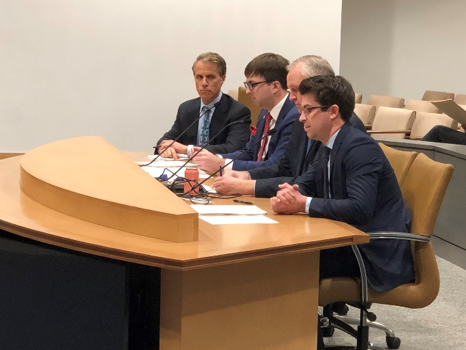Governor Walz and Lt. Governor Flanagan Announce Budget Proposal
Last week, Governor Walz and Lt. Governor Flanagan put forward their first budget proposal for the State of Minnesota. Their budget proposes to spend $49.471 billion over the next two years; for reference, the current budget spends a total of $45.585 billion. It contains numerous changes to existing spending and policies, in addition to several new proposals. This summary highlights some of the key parts of interest to Medical Alley Association members and also touches on other noteworthy budget provisions.
Medical Alley Association issued a statement shortly after the release of the budget, which touches on two of the proposals found in the Governor’s budget: reinstating the Angel Investment Tax Credit and creating a Minnesota Innovation Collaborative. You can see the full statement here.
Provisions of Interest to Medical Alley Association Members
Reinstate the Angel Investment Tax Credit
$10 million Fiscal Year 2020/$10 million Fiscal Year 2021
As previously indicated, this budget proposes reinstating the Angel Investment Tax Credit. Gov. Walz’s budget would bring this credit back for two years at $10 million per year. It also puts forward small modifications to the program to better serve targeted group businesses under the statute (e.g. minority- or women-owned businesses or businesses located in Greater Minnesota).
Reinstating the Angel Investment Tax Credit is a part of Medical Alley Association’s 2019 State Legislative Agenda. We are greatly appreciative of the Governor & Lt. Governor’s support of this program and look forward to working with his administration on getting it over the finish line.
Creating a Minnesota Innovation Collaborative (MIC)
$4.5 million Fiscal Year 2020/$4.5 million Fiscal Year 2021
The budget is also proposing to establish a one-stop shop to support and enhance the visibility of, and interest in, Minnesota’s innovation ecosystem. The goal of the program is to make the state a top destination for both homegrown talent and outside entrepreneurs to start, build, and grow businesses.
The MIC, as proposed, would be a center for grant programs, a physical space for education and training, and a new apprenticeship program. The goal of the MIC is to bring together key players throughout the ecosystem: founders, venture capitalists, researchers, academics, and business leaders.
According to the budget proposal, the innovation ecosystem in Minnesota is not well defined and there is no central organizing body or effort to coordinate or promote the ecosystem. The plan is for the MIC to eventually spin parts off into the private sector as they grow. In addition, DEED staff will be reaching out provide state investments to sustain and grow locations and services beyond this biennium.
We are looking forward to working with DEED Commissioner Grove and the rest of DEED staff on this proposal. This is a significant acknowledgement that more needs to be done to improve Minnesota’s startup ecosystem.
Federal Tax Conformity (for businesses)
Governor Walz & Lt. Governor Flanagan propose conforming with many of the changes made at the federal level in 2017 – albeit with two significant changes. First, is disallowing the 20 percent deduction for qualified pass-through businesses. Second, the proposal does not allow for the federal deduction of foreign-derived intangible income (FDII) that is derived from a domestic corporation.
Additionally, they propose fully and permanently conforming to changes in Section 179 expensing. This includes, for property placed into service beginning in 2018, eliminating the 80 percent add-back that is currently required under state law. The proposal does conform to the new limits on bonus depreciation, but retains the 80 percent add-back provisions currently in state law.
Other Tax Changes
There are a few other key tax changes proposed in Governor Walz’s budget:
- Restoring the inflator to the State General Levy (also known as the Statewide Business Property Tax). This was repealed in 2017 and under this proposal would take effect again for taxes payable in 2020. This property tax is assessed on a set value in law across all commercial/industrial property in the state.
- Modifies the data center sales tax exemption for companies that have already taken advantage of the incentive and new ones going forward. This change has the effect of lessening the value of the incentive to those already using it and those looking to access it in the future.
- Repeals the repeal of the Provider Tax. This is a 2 percent tax that is currently assessed on revenues from patient providers and currently scheduled to sunset at the end of 2019. This proposal would eliminate that sunset, keeping the tax in effect permanently. This tax is currently used to fund the Health Care Access Fund (HCAF), which supports MinnesotaCare and Medical Assistance, and would increase revenues to HCAF by over $725 million annually. Reinstating the tax would trigger a surplus in this fund that results in an automatic transfer into the General fund of $122 million per year.
ONECare
This is the Administration’s proposal for a MinnesotaCare buy-in and state negotiation of prescription drug prices, among other changes.
ONECare creates a public option through providing a platinum-level product in Minnesota’s individual market. This product would compete with private options. It would have a benefit set similar to MinnesotaCare. Reimbursements to providers would, according to the budget release, be no lower than Medicare rates. The Governor’s budget asserts that after an initial startup investment the program would be paid for by premiums. This product would be available beginning in 2022 and consumers would be eligible for federal tax credits.
In addition, beginning in 2024, if an area of the state only has one option for health plan coverage, DHS will offer two buy-in products equivalent to a Gold or Silver plan.
A 1332 waiver will be required to fully capture savings from the federal government and to lower the costs for those purchasing the platinum product.
State Negotiation of Prescription Drugs
The Administration is also proposing to have the state leverage the negotiating power of state programs and have DHS administer the benefits for Medical Assistance, MinnesotaCare, and eventually the buy-in products. This plan would do away with the current system of Managed Care Organizations and PBMs. This will, according to the Governor’s budget, save the state money through pooled negotiation. The plan also notes that other groups could be included in the future, such as employer-based or self-insured products.
Opioid Stewardship Fee & Licensing Fee
To help address the opioid epidemic, the Governor & Lt. Governor are proposing to generate revenue via two separate fees on parts of the prescription drug supply chain. The dollars raised would then be spent on a myriad of programs, including out-of-home placement, grants to addiction recovery and prevention groups, and organizations that work with Native Americans.
Controlled Substances Registration Program
This would establish a controlled substance registration system. Drug manufacturers, drug wholesalers, pharmacies, prescribers, and controlled substance researchers would be required to pay a fee if they are involved in the manufacture, sale, prescribing, or handling of any controlled substance.
Opioid Wholesaler and Manufacturer Registration Fees
This is a similar proposal to what the House and Senate are separately working on. It would raise $18 million per year ($11m from manufacturers, $7m from wholesalers) assessed based on units sold, delivered, or distributed by company within Minnesota.
Other Noteworthy Provisions
Changes to transportation related taxes & fees
The budget proposal puts forward a suite of changes to transportation-related taxes and fees to fund additional transportation spending. These changes include:
- 20 cent increase in the gas tax phased in
throughout 2020 and 2021 (to a total of 48.5 cents/gallon)
- Minnesota is currently ranked 28th highest in the country for gas taxes
- Indexing the gas tax to inflation (over a 10-year period, this is projected to add another 29 cents per gallon to the gas tax)
- Increasing the registration tax, effective
January 1, 2020
- This is done a number of ways including increasing the tax base rate and changing the depreciation schedule
- Increasing the motor vehicle sales tax from 6.5 percent to 6.875 percent beginning December 1, 2019
These changes raise just over $900 million in FY20-21 and $1.72 billion in FY22-23. These dollars will be spent on improving the transportation network – primarily roads and bridges – throughout Minnesota.
Education Funding
The Administration is proposing a 3 percent increase, or $189 per student, to the general education formula in FY2020 and an additional 2 percent, or $130 per student, increase in 2021. This totals more than $525 million dollars of additional spending on the general education formula in this budget cycle. This budget also proposes to keep the number of slots for voluntary pre-kindergarten static (it was scheduled to decrease) and continues significant state support of special education costs for school districts.
In Session With Medical Alley – Senator Steve Cwodzinski
In Session with Medical Alley hopes to familiarize legislators and the Medical Alley community with each other. This week’s on camera interview features Senator Steve Cwodzinski (Democrat- Eden Prairie).
Senator Cwodzinski spent the better part of his life as an American Government teacher. He empowered countless students to stand up for what they believed in because their voices mattered. After 30 years of teaching the importance of civic duty, he practiced what he preached and ran for the State Senate. Join us in getting to know your legislator, the man with a captivating personality, a passion for democracy and a desire to better everyone’s lives, Senator Steve Cwodzinski from senate district 48.
Bill to Reinstate Angel Investment Tax Credit Moves Forward After Hearing in Senate Committee
Last Wednesday, the Senate Jobs and Economic Development Committee held a hearing on Sen. Paul Anderson’s bill (SF788) to reinstate and make permanent the Angel Investment Tax Credit (AITC). John Nealon, President & CEO of UroCure, LLC, testified in support of the legislation. He spoke about how the AITC was invaluable to him when starting his company by helping provide the opportunity to grow and establish itself early on. He also shared that having the AITC in place keeps Minnesota startups competitive with peer states for critical early investment dollars.

Thank you, John, for coming to the legislature to talk first-hand about the benefits of the AITC and thanks to Senator Paul Anderson for authoring this important legislation for Minnesota’s startup ecosystem. We look forward to working with him as this bill continues to move forward in the Minnesota Senate.
Lilly’s Legislative Life
This past week Medical Alley had a flurry of meetings. On Monday we participated in our first press conference supporting the Rare Disease Advisory Council. On Tuesday the Governor released his One Minnesota budget while lobbyists scanned through spreadsheets to see if their provisions had made the cut. By Wednesday Minnesota had what felt like its 37th snow day and we had our first bill hearing in the Senate on the Angel Investment Tax Credit. The rest of the week consisted of back-to-back meetings while attempting to catch legislators on their way to committee and floor session. Week 8 will consist of commissioners going over their agency budget in their respective committees. Be on the lookout for lots of committee notes this week.
Here’s hoping for a snowless week. See you all in Week 9.
